battery capacity TOYOTA HIGHLANDER 2020 Owners Manual (in English)
[x] Cancel search | Manufacturer: TOYOTA, Model Year: 2020, Model line: HIGHLANDER, Model: TOYOTA HIGHLANDER 2020Pages: 560, PDF Size: 14.42 MB
Page 485 of 560
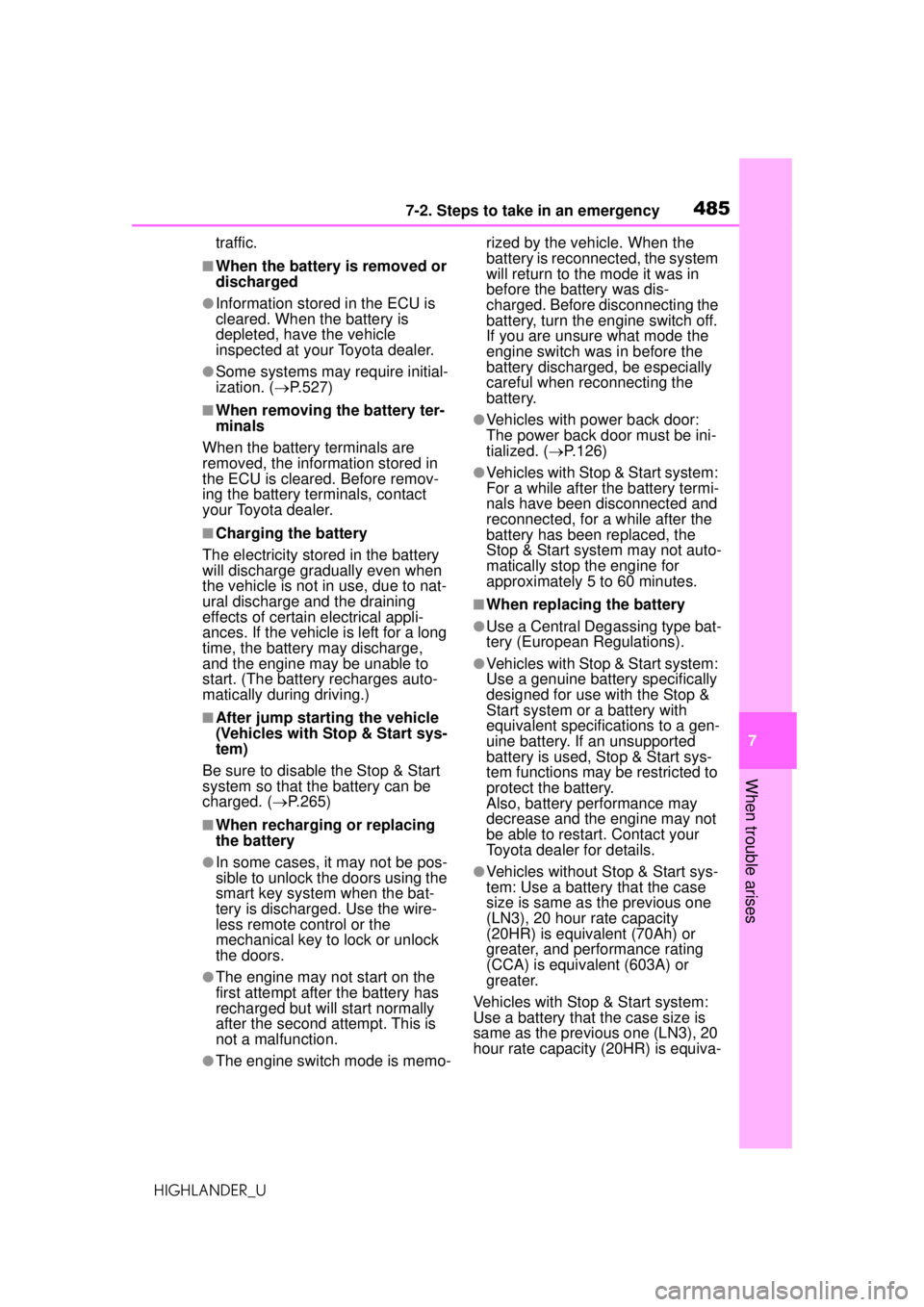
4857-2. Steps to take in an emergency
HIGHLANDER_U
7
When trouble arises
traffic.
■When the battery is removed or
discharged
●Information stored in the ECU is
cleared. When the battery is
depleted, have the vehicle
inspected at your Toyota dealer.
●Some systems may require initial-
ization. ( P.527)
■When removing the battery ter-
minals
When the battery terminals are
removed, the information stored in
the ECU is cleared. Before remov-
ing the battery terminals, contact
your Toyota dealer.
■Charging the battery
The electricity stored in the battery
will discharge gradually even when
the vehicle is not in use, due to nat-
ural discharge and the draining
effects of certain electrical appli-
ances. If the vehicle is left for a long
time, the battery may discharge,
and the engine may be unable to
start. (The battery recharges auto-
matically during driving.)
■After jump starting the vehicle
(Vehicles with Stop & Start sys-
tem)
Be sure to disable the Stop & Start
system so that the battery can be
charged. ( P.265)
■When recharging or replacing
the battery
●In some cases, it may not be pos-
sible to unlock the doors using the
smart key system when the bat-
tery is discharged. Use the wire-
less remote control or the
mechanical key to lock or unlock
the doors.
●The engine may not start on the
first attempt after the battery has
recharged but w ill start normally
after the second a ttempt. This is
not a malfunction.
●The engine switch mode is memo- rized by the vehicle. When the
battery is reconnected, the system
will return to the
mode it was in
before the battery was dis-
charged. Before disconnecting the
battery, turn the engine switch off.
If you are unsure what mode the
engine switch was in before the
battery discharged, be especially
careful when reconnecting the
battery.
●Vehicles with power back door:
The power back door must be ini-
tialized. ( P.126)
●Vehicles with Stop & Start system:
For a while after the battery termi-
nals have been disconnected and
reconnected, for a while after the
battery has been replaced, the
Stop & Start system may not auto-
matically stop the engine for
approximately 5 to 60 minutes.
■When replacing the battery
●Use a Central Degassing type bat-
tery (European Regulations).
●Vehicles with Stop & Start system:
Use a genuine battery specifically
designed for use with the Stop &
Start system or a battery with
equivalent specifications to a gen-
uine battery. If an unsupported
battery is used, Stop & Start sys-
tem functions may be restricted to
protect the battery.
Also, battery performance may
decrease and the engine may not
be able to restart. Contact your
Toyota dealer for details.
●Vehicles without Stop & Start sys-
tem: Use a battery that the case
size is same as the previous one
(LN3), 20 hour rate capacity
(20HR) is equivalent (70Ah) or
greater, and performance rating
(CCA) is equivalent (603A) or
greater.
Vehicles with Stop & Start system:
Use a battery that the case size is
same as the previous one (LN3), 20
hour rate capacity (20HR) is equiva-
Page 486 of 560

4867-2. Steps to take in an emergency
HIGHLANDER_Ulent (65Ah) or greater, and perfor-
mance rating (CCA) is equivalent
(603A) or greater.
• If the sizes differ, the battery can-
not be properly secured.
• If the 20 hour rate capacity is low,
even if the time period where the
vehicle is not used is a short time,
the battery may discharge and the
engine may not be able to start.
For details, consult your Toyota
dealer.
WARNING
■When removing the battery
terminals
Always remove the negative (-)
terminal first. If the positive (+) ter-
minal contacts any metal in the
surrounding area when the posi-
tive (+) terminal is removed, a
spark may occur, le ading to a fire
in addition to electrical shocks
and death or serious injury.
■Avoiding battery fires or
explosions
Observe the following precautions
to prevent accidentally igniting the
flammable gas that may be emit-
ted from the battery:
●Make sure each jumper cable is
connected to the correct termi-
nal and that it is not unintention-
ally in contact with any other
than the intended terminal.
●Do not allow the other end of
the jumper cable connected to
the “+” terminal to come into
contact with any other parts or
metal surfaces in the area, such
as brackets or unpainted metal.
●Do not allow the + and - clamps
of the jumper cables to come
into contact with each other.
●Do not smoke, use matches,
cigarette lighters or allow open
flame near the battery.
■Battery precautions
The battery contains poisonous
and corrosive acidic electrolyte,
while related parts contain lead
and lead compounds. Observe
the following precautions when
handling the battery:
●When working with the battery,
always wear safety glasses and
take care not to allow any bat-
tery fluids (acid) to come into
contact with skin, clothing or the
vehicle body.
●Do not lean over the battery.
●In the event that battery fluid
comes into contact with the skin
or eyes, immediately wash the
affected area with water and
seek medical attention. Place a
wet sponge or cloth over the
affected area until medical
attention can be received.
●Always wash your hands after
handling the battery support,
terminals, and other bat-
tery-related parts.
●Do not allow children near the
battery.
■When replacing the battery
●When the vent plug and indica-
tor are close to the hold down
clamp, the battery fluid (sulfuric
acid) may leak.
●For information regarding bat-
tery replacement, contact your
Toyota dealer.
NOTICE
■When handling jumper cables
When connecting the jumper
cables, ensure that they do not
become entangled in the cooling
fan or engine drive belt.
Page 497 of 560
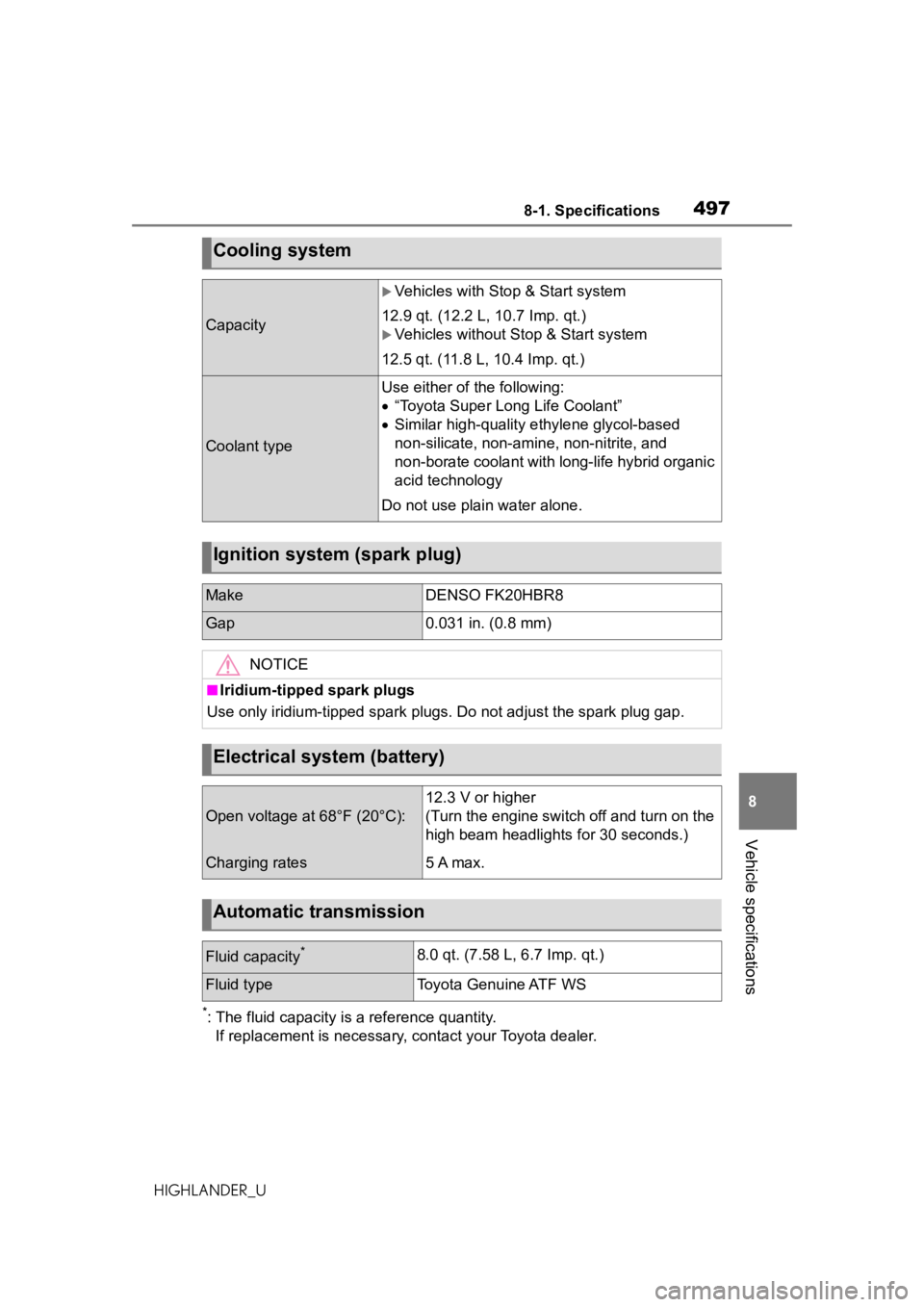
4978-1. Specifications
HIGHLANDER_U
8
Vehicle specifications
*: The fluid capacity is a reference quantity.
If replacement is necessary, contact your Toyota dealer.
Cooling system
Capacity
Vehicles with Stop & Start system
12.9 qt. (12.2 L, 10.7 Imp. qt.)
Vehicles without Stop & Start system
12.5 qt. (11.8 L, 10.4 Imp. qt.)
Coolant type
Use either of the following:
“Toyota Super Long Life Coolant”
Similar high-quality ethylene glycol-based
non-silicate, non-amine, non-nitrite, and
non-borate coolant with long-life hybrid organic
acid technology
Do not use plain water alone.
Ignition system (spark plug)
MakeDENSO FK20HBR8
Gap0.031 in. (0.8 mm)
NOTICE
■Iridium-tipped spark plugs
Use only iridium-tipped spark plugs. Do not adjust the spark plug gap.
Electrical system (battery)
Open voltage at 68°F (20°C):
12.3 V or higher
(Turn the engine switch off and turn on the
high beam headlights for 30 seconds.)
Charging rates5 A max.
Automatic transmission
Fluid capacity*8.0 qt. (7.58 L, 6.7 Imp. qt.)
Fluid typeToyota Genuine ATF WS
Page 510 of 560
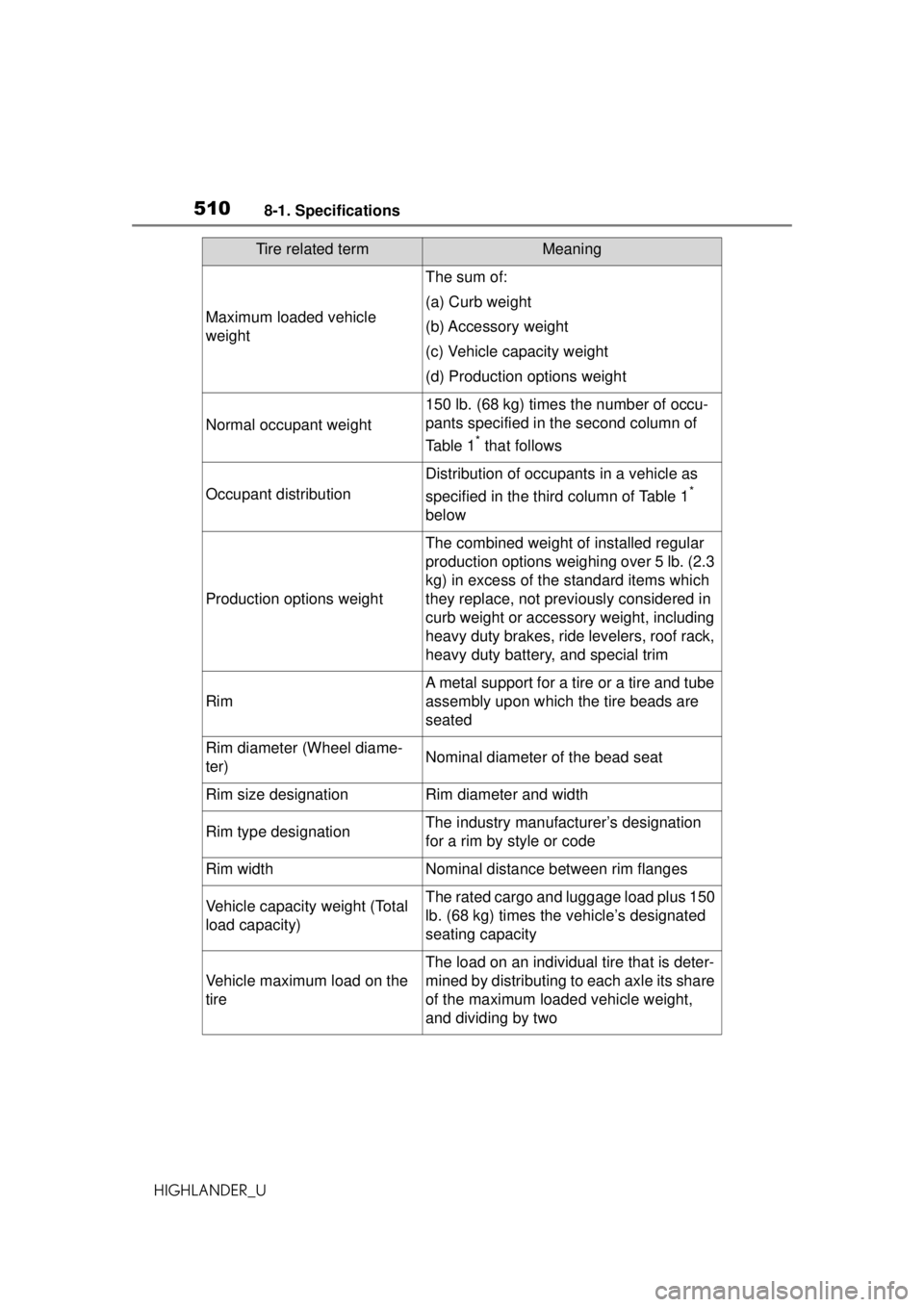
5108-1. Specifications
HIGHLANDER_U
Maximum loaded vehicle
weight
The sum of:
(a) Curb weight
(b) Accessory weight
(c) Vehicle capacity weight
(d) Production options weight
Normal occupant weight
150 lb. (68 kg) times the number of occu-
pants specified in the second column of
Table 1
* that follows
Occupant distribution
Distribution of occupants in a vehicle as
specified in the third column of Table 1
*
below
Production options weight
The combined weight of installed regular
production options weighing over 5 lb. (2.3
kg) in excess of the standard items which
they replace, not previously considered in
curb weight or accessory weight, including
heavy duty brakes, ride levelers, roof rack,
heavy duty battery, and special trim
Rim
A metal support for a tire or a tire and tube
assembly upon which the tire beads are
seated
Rim diameter (Wheel diame-
ter)Nominal diameter of the bead seat
Rim size designationRim diameter and width
Rim type designationThe industry manufacturer’s designation
for a rim by style or code
Rim widthNominal distance between rim flanges
Vehicle capacity weight (Total
load capacity)The rated cargo and luggage load plus 150
lb. (68 kg) times the vehicle’s designated
seating capacity
Vehicle maximum load on the
tire
The load on an individual tire that is deter-
mined by distributing to each axle its share
of the maximum loaded vehicle weight,
and dividing by two
Tire related termMeaning
Page 546 of 560

546Alphabetical Index
HIGHLANDER_U
Automatic light control system ............................................... 215
Automatic transmission ........ 204 If the shift lever cannot be shifted from P................................. 206
M mode ................................ 206
Auxiliary boxes ............... 361, 366
Average fuel economy ....... 84, 92
Average vehicle speed....... 86, 95
AWD Control ....................... 87, 95
B
Back door ................................ 119
Back-up lights Replacing light bulbs ............ 432
Battery Battery checking................... 408
If the battery is discharged ... 483
Preparing and checking before winter.................................. 319
Replacing ............................. 485
Warning light ........................ 451
Blind Spot Monitor (BSM) ...... 270
Brake Brake hold ............................ 212
Fluid ............................. 408, 499
Parking brake ....................... 209
Warning light ........................ 450
Brake assist ............................ 313
Break-in tips ........................... 178
Brightness control Instrument panel light control . 81
BSM (Blind Spot Monitor) ...... 270
Buzzer Hands off steering wheel warn-ing (LTA) ............................. 249
C
Care Exterior ................................. 388
Interior .................................. 391 Seat belts .............................391
Wheels and wheel ornaments
...........................................388
Cargo capacity ........................187
Cargo net hooks .....................363
Chains......................................320
Child restraint system Fixed with a LATCH system ...58
Fixed with a seat belt..............53
Front passenger occupant clas-sification system ...................41
Points to remember ................48
Riding with children ................47
Types of child restraint system installation method ...............50
Using an anchor bracket ........60
Child safety Airbag precautions .................37
Back door precautions.......... 119
Battery precautions ......409, 486
Child restraint system .............50
Heated steering wheel and seat heater precautions..............352
How your child should wear the seat belt ................................26
Moon roof precautions..........168
Panoramic moon roof precau- tions ....................................172
Power window lo ck switch ....166
Power window precautions...165
Rear door child-protectors .... 118
Removed electronic key battery precautions .........................429
Seat belt extender precautions .............................................27
Seat belt precautions..............47
Child-protectors...................... 118
Cleaning Exterior .................................388
Interior ..................................391
Radar sensor ........................228
Seat belts .............................391
Page 548 of 560
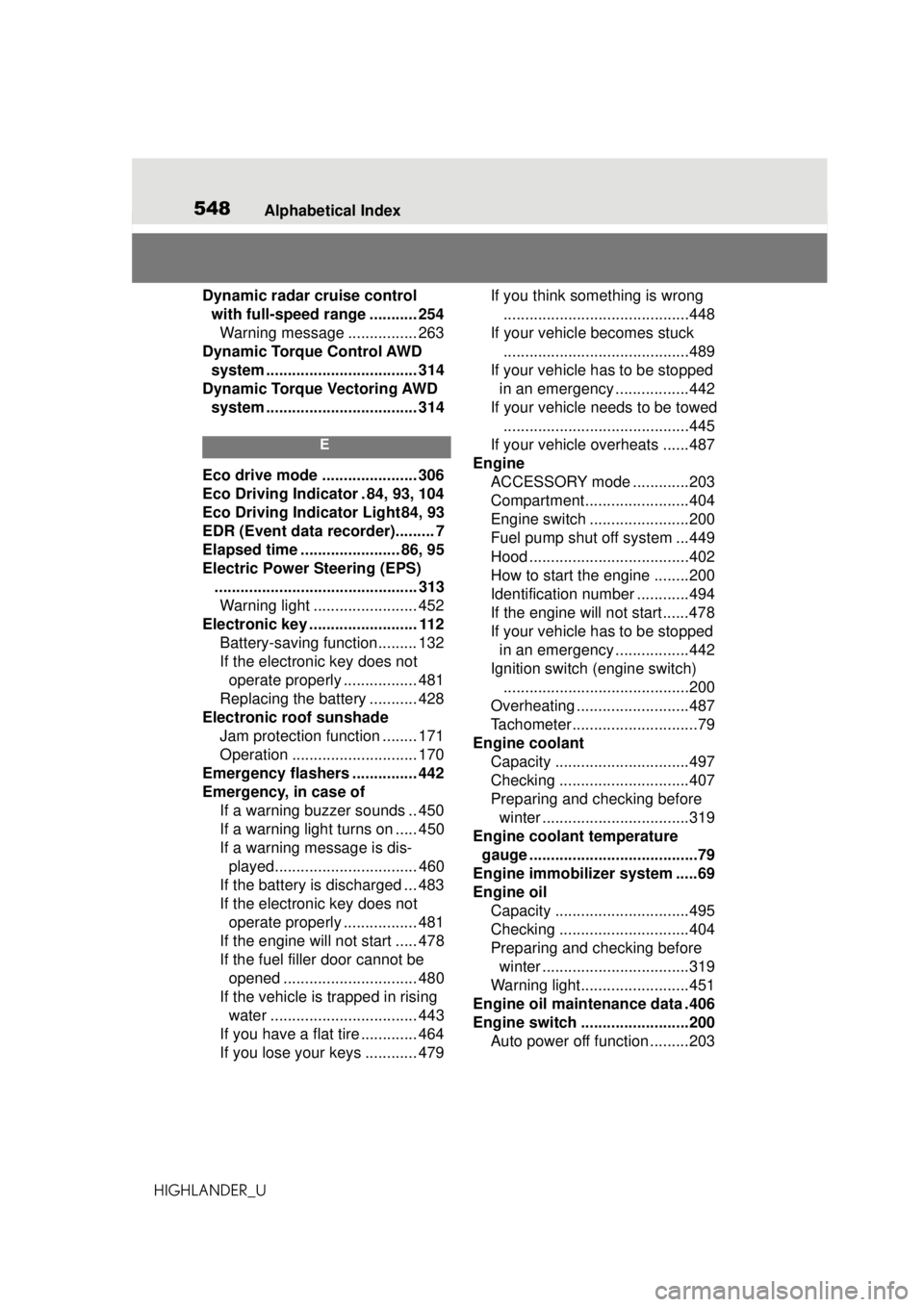
548Alphabetical Index
HIGHLANDER_U
Dynamic radar cruise control with full-speed range ........... 254Warning message ................ 263
Dynamic Torque Control AWD system ................................... 314
Dynamic Torque Vectoring AWD system ................................... 314
E
Eco drive mode ...................... 306
Eco Driving Indicator . 84, 93, 104
Eco Driving Indicator Light84, 93
EDR (Event data recorder)......... 7
Elapsed time ....................... 86, 95
Electric Power Steering (EPS) ............................................... 313Warning light ........................ 452
Electronic key ......................... 112 Battery-saving function......... 132
If the electronic key does not operate properly ................. 481
Replacing the battery ........... 428
Electronic roof sunshade Jam protection function ........ 171
Operation ............................. 170
Emergency flashers ............... 442
Emergency, in case of If a warning buzzer sounds .. 450
If a warning light turns on ..... 450
If a warning message is dis-played................................. 460
If the battery is discharged ... 483
If the electronic key does not operate properly ................. 481
If the engine will not start ..... 478
If the fuel filler door cannot be opened ............................... 480
If the vehicle is trapped in rising water .................................. 443
If you have a flat tire ............. 464
If you lose your keys ............ 479 If you think something is wrong
...........................................448
If your vehicle becomes stuck ...........................................489
If your vehicle has to be stopped in an emergency .................442
If your vehicle ne eds to be towed
...........................................445
If your vehicle overheats ......487
Engine ACCESSORY mode .............203
Compartment........................404
Engine switch .......................200
Fuel pump shut off system ...449
Hood .....................................402
How to start the engine ........200
Identification number ............494
If the engine will not start......478
If your vehicle has to be stopped in an emergency .................442
Ignition switch (engine switch) ...........................................200
Overheating ..........................487
Tachometer.............................79
Engine coolant Capacity ...............................497
Checking ..............................407
Preparing and checking before winter ..................................319
Engine coolant temperature gauge .......................................79
Engine immobilizer system .....69
Engine oil Capacity ...............................495
Checking ..............................404
Preparing and checking before winter ..................................319
Warning light.........................451
Engine oil maintenance data .406
Engine switch .........................200 Auto power off function .........203
Page 553 of 560
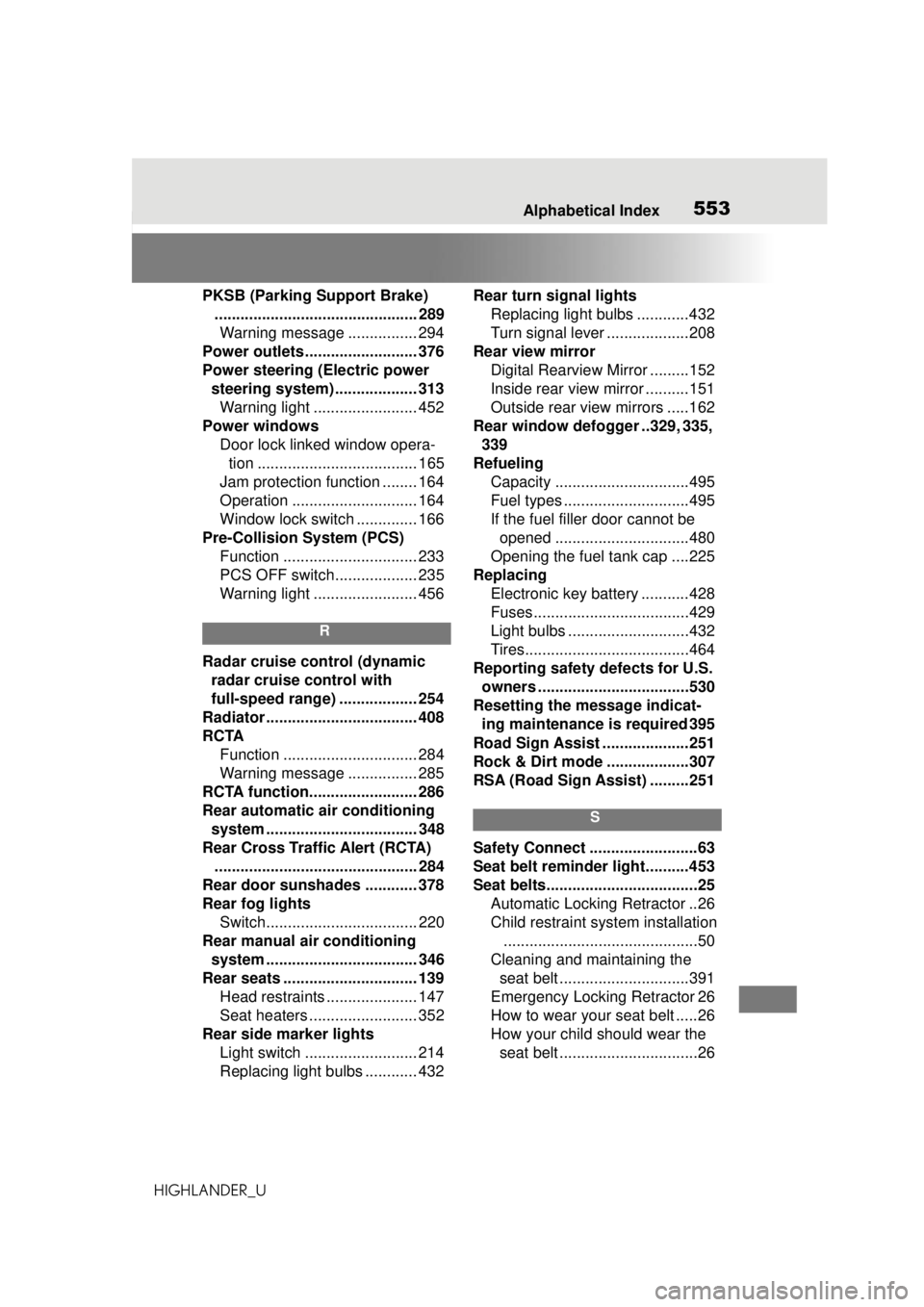
553Alphabetical Index
HIGHLANDER_U
PKSB (Parking Support Brake) ............................................... 289Warning message ................ 294
Power outlets .......................... 376
Power steering (Electric power steering system)................... 313Warning light ........................ 452
Power windows Door lock linked window opera-tion ..................................... 165
Jam protection function ........ 164
Operation ............................. 164
Window lock switch .............. 166
Pre-Collision System (PCS) Function ............................... 233
PCS OFF switch................... 235
Warning light ........................ 456
R
Radar cruise control (dynamic radar cruise control with
full-speed range) .................. 254
Radiator ................................... 408
RCTA Function ............................... 284
Warning message ................ 285
RCTA function......................... 286
Rear automatic air conditioning system ................................... 348
Rear Cross Traffic Alert (RCTA) ............................................... 284
Rear door sunshades ............ 378
Rear fog lights Switch................................... 220
Rear manual air conditioning system ................................... 346
Rear seats ............................... 139 Head restraints ..................... 147
Seat heaters ......................... 352
Rear side marker lights Light switch .......................... 214
Replacing light bulbs ............ 432 Rear turn signal lights
Replacing light bulbs ............432
Turn signal lever ...................208
Rear view mirror Digital Rearview Mirror .........152
Inside rear view mirror ..........151
Outside rear view mirrors .....162
Rear window defogger ..329, 335, 339
Refueling Capacity ...............................495
Fuel types .............................495
If the fuel filler door cannot be opened ...............................480
Opening the fuel tank cap ....225
Replacing Electronic key battery ...........428
Fuses....................................429
Light bulbs ............................432
Tires......................................464
Reporting safety defects for U.S. owners ...................................530
Resetting the message indicat- ing maintenance is required 395
Road Sign Assist ....................251
Rock & Dirt mode ...................307
RSA (Road Sign Assist) .........251
S
Safety Connect .........................63
Seat belt reminder light..........453
Seat belts...................................25 Automatic Locking Retractor ..26
Child restraint system installation.............................................50
Cleaning and maintaining the seat belt ..............................391
Emergency Locking Retractor 26
How to wear your seat belt .....26
How your child should wear the seat belt ................................26